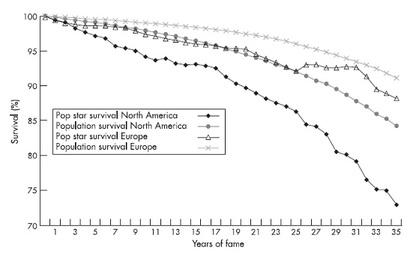Addiction & The Humanities Vol. 4(2) – Live Fast, Die Young? Maybe Not.
Media reports and speculation associate celebrity status with early death. Supporting this relationship, qualitative research has concluded that celebrities are more likely to suffer from stress, substance use, and depression, which are risk factors for early death (Patalano, 2000; Raeburn, 1999). This week’s BASIS explores quantitative research about this topic. In “Elvis to Eminem,” Mark Bellis and his colleagues hypothesized that “popstars” would have a higher mortality rate than individuals from matching demographics (e.g., age, sex, and race) in the general population (Bellis et al., 2007).
Bellis et al. focused on European and North American music stars within six genres: rock, punk, rap, R&B (rhythm and blues), electronica, and new age. The researchers calculated celebrities’ total years of life since becoming famous and compared the result to the UK and US general populations’ expected rates of survival. They standardized the general population survival rates for age, sex, and for North American analyses, ethnicity. Bellis et al. found a significant difference between US and UK music stars’ survival rate after 25 years of fame. For European music stars, the relative survival probability increases until the difference between it and the general population’s survival rate is not significant. As shown in Figure 1, for North American “popstars,” the relative survival rate continues to deviate from that of their European counterparts and from that of their matched populations.

Figure 1: Comparative survival curves for North American and European pop stars and demographically matched general populations (Bellis et al., 2007).
The study of the 1,064 music stars also found that an overdose or a chronic drug or alcohol problem caused more than a quarter of music star deaths; however, the crude mortality (i.e., death rate for the entire population including all sexes, ages, and causes) of European music stars was only half of that for North American stars.
The findings of Bellis et al were limited by their operational definition of stardom (i.e., choice of an international poll from the year 2000 that determined the All-Time 1000 Albums). Another limitation was their definition of date of fame, which was not based on any epidemiological standards, but on the artists’ earliest date of chart success, which resulted in slightly more conservative results. A third limitation was their failure to use official cause of death records in their research, rather than a range of non-traditional sources (i.e., cross- referenced over 430 websites, books, etc.). Lastly, the use of US and UK life tables as substitutes for North American and European measures also limited the study.
Bellis et al propose greater collaboration between the health and music industries to help assure that pop star influence leads to better health among fans and rising stars that look to them as leaders. However, it may be more interesting to propose that the music industry provide newest music stars with preventative tools, treatment, and resources to prevent unhealthy lifestyles. Moreover, the same research conclusions and suggestion could be applied to other non-music celebrities. The nature of stress that celebrities face in combination with the easily accessible substances suggest that a certain amount of preparation for this change in lifestyle is necessary to successfully navigate the celebrity world and avoid widely publicized addiction or premature death.
What do you think? Comments can be addressed to Ingrid R. Maurice.
References
Bellis, M. A., Hennell, T., Lushey, C., Hughes, K., Tocque, K., & Ashtan, J. R. (2007). Elvis to Eminem: quantifying the price of fame through early mortality of European and North American rock and pop stars. Journal of Epidemiology & Community Health, 61(10), 896-901.
Patalano, F. (2000). Psychological stressors and the short life spans of legendary jazz musicians. Perceptual & Motor Skills, 90(2), 435-436.
Raeburn, S. (1999). Psychological issues and treatment strategies in popular musicians. A review, part 1. Medical Problems of Performing Artists, 4(1), 171-179.